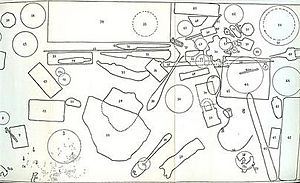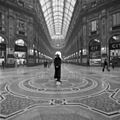Daniel Spoerri facts for kids
Daniel Spoerri (born 1930 – died 2024) was a Swiss artist and writer. He was born in Romania. Spoerri is best known for his "snare-pictures." These are artworks where he fixed everyday objects in place. For example, he would take the remains of a meal, including plates, forks, and glasses. He would glue them all to the table. Then, he would hang the table on a wall like a painting.
He was also famous for his book, An Anecdoted Topography of Chance. In this book, he listed all the objects on his table at a certain time. He then wrote about each object, sharing personal memories. It was like a written version of his snare-pictures.
Contents
Early Life and Art Beginnings
Daniel Spoerri was born Daniel Isaac Feinstein on March 27, 1930. He was born in Galați, Romania. His father was killed in 1941 during the war. His mother was Swiss, so she could move the family to Switzerland in 1942. He was adopted by his uncle, Professor Theophil Spoerri. He then became known as Daniel Spoerri.
In the 1950s, Spoerri was a dancer. He studied classical dance. In 1954, he became the main dancer at the State Opera of Bern, Switzerland. He also directed modern plays. During this time, he met many famous artists. These included Marcel Duchamp and Man Ray. He also met artists linked to the Fluxus movement, like Robert Filliou.
Editions MAT
In 1959, Spoerri started a company called Editions MAT. The name meant "Multiplication d'art Transformable." This company made and sold copies of 3D artworks. Artists like Marcel Duchamp and Jean Tinguely created works for Editions MAT. One well-known piece was Man Ray's Indestructible Object. Spoerri is known for calling these copies "multiples."
Snare-Pictures (Tableaux-Pièges)
Spoerri made his first "snare-picture" in 1960. He explained them as "objects found in chance positions." These objects could be on tables or in drawers. He would then fix them in place exactly as they were. The only change was that the horizontal surface became vertical. He would hang it on a wall like a picture.
For example, he would glue the leftovers of a meal to the table. Then he would hang the table on the wall. His first snare-picture was Kichka's Breakfast. It was made from his girlfriend's leftover breakfast. This artwork is now in the Museum of Modern Art in New York. Another snare-picture from 1964 used the remains of a meal eaten by Marcel Duchamp.
An Anecdoted Topography of Chance
In 1962, Spoerri wrote his book Topographie Anécdotée* du Hasard. This was for a show of his snare-pictures in Paris. At the time, Spoerri lived in a hotel room. His wife had painted the table in his room blue.
Spoerri drew a "map" of all 80 objects on his table. This was on October 17, 1961, at exactly 3:47 p.m. Each object had a number. Spoerri wrote a short description of each object. He also shared memories or stories linked to them. The book was first a small pamphlet. It was given out as an advertisement for his art show.
This book is more than just a list of random objects. It tells a story about Spoerri's travels, friends, and art. In 1966, an English version was published. It included drawings by Roland Topor. Later versions added more notes and texts by other artists.
New Realism
Spoerri was one of the first artists to sign the manifesto for the Nouveau réalisme (New Realism) art movement. This movement started in 1960. It was an avant-garde (very new and experimental) art group. New Realism artists used everyday life as the main subject for their art. This shows how Spoerri's work fit into this movement.
Fluxus
Spoerri is also linked to the Fluxus art movement. This movement began in the early 1960s. Fluxus artists loved being spontaneous and using humor. They were a diverse group of artists. Many people say Spoerri's Anecdoted Topography of Chance perfectly shows the spirit of Fluxus.
Eat Art
A big part of Spoerri's art was about food. He called this "Eat Art." One type of Eat Art was his "snare-pictures of eaten meals." As mentioned, he would fix leftovers to a table and hang it.
In 1961, he sold canned food in an art gallery in Copenhagen. He had signed and stamped the cans with "Attention: Work of Art." In 1963, he created a performance art piece called Restaurant de la Galerie J in Paris. He cooked meals on several evenings. Art critics acted as waiters. This played on the idea of critics bringing art to people.
In 1968, Spoerri opened the Restaurant Spoerri in Düsseldorf. He opened the Eat-Art-Gallery upstairs in 1970. He also published a diary in 1970 about his life on the Greek island of Symi. It included many recipes he ate there. The book was later called Mythology & Meatballs.
Later Work and Garden
Spoerri continued to make snare-pictures into the 1990s. This included his famous eaten meal artworks. He also made other artworks by attaching objects to old medical drawings. Spoerri also created prints and bronze versions of his art.
Spoerri lived in many places, like Bern, Paris, and Vienna. In 1997, he moved to Seggiano in Tuscany, Italy. There, he opened Il Giardino di Daniel Spoerri. This is a sculpture garden where artworks by many artists are shown.
Exhibitions
- 1992: Expo ’92, Swiss pavilion, Seville.
- 2001: Museum Jean Tinguely, Basel.
- 2009: Ludwig Museum, Koblenz (Germany).
- 2012: Natural History Museum, Vienna, Austria.
- 2013: Historia Rerum Rariorum, Museumsberg Flensurg, North of Germany.
- 2014: Il Bistrot di Santa Marta, Fondazione Mudima, Milan.
- 2015: Eat Art in Transformation, Civic Gallery, Modena.
- 2017: Autour de Nouveau Réalisme. Daniel Spoerri - Les dadas des deux, Musée Les Abattoirs, Toulouse.
- 2017: Rearranging the world, Boxart Gallery, Verona.
Images for kids
See also
 In Spanish: Daniel Spoerri para niños
In Spanish: Daniel Spoerri para niños




